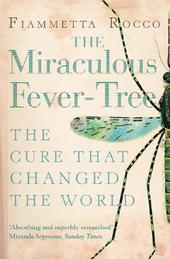
|
The Miraculous Fever-Tree: Malaria, Medicine and the Cure that Changed the World
Paperback / softback
Main Details
| Title |
The Miraculous Fever-Tree: Malaria, Medicine and the Cure that Changed the World
|
| Authors and Contributors |
By (author) Fiammetta Rocco
|
| Physical Properties |
| Format:Paperback / softback | | Pages:368 | | Dimensions(mm): Height 198,Width 129 |
|
| Category/Genre | Popular science |
|---|
| ISBN/Barcode |
9780006532354
|
| Classifications | Dewey:633.88393 |
|---|
| Audience | | Tertiary Education (US: College) | |
|---|
| Illustrations |
16 b/w plates (16pp), (4 x 4pp black & white plate sections)
|
|
Publishing Details |
| Publisher |
HarperCollins Publishers
|
| Imprint |
HarperCollins Publishers Ltd
|
| Publication Date |
15 March 2004 |
| Publication Country |
United Kingdom
|
Description
A rich and wonderful history of quinine -- the cure for malaria. In the summer of 1623, ten cardinals and hundreds of their attendants, engaged in electing a new Pope, died from the 'mal'aria' or 'bad air' of the Roman marshes. Their choice, Pope Urban VIII, determined that a cure should be found for the fever that was the scourge of the Mediterranean, northern Europe and America, and in 1631 a young Jesuit apothecarist in Peru sent to the Old World a cure that had been found in the New -- where the disease was unknown. The cure was quinine, an alkaloid made of the bitter red bark of the cinchona tree, which grows in the Andes. Both disease and cure have an extraordinary history. Malaria badly weakened the Roman Empire. It killed thousands of British troops fighting Napoleon during the Walcheren raid on Holland in 1809 and many soldiers on both sides of the American Civil War. It turned back many of the travellers who explored west Africa and brought the building of the Panama Canal to a standstill. When, after a thousand years, a cure was finally found, Europe's Protestants, among them Oliver Cromwell, who suffered badly from malaria, feared it was nothing more than a Popish poison. More than any previous medicine, though, quinine forced physicians to change their ideas about treating illness. Before long, it would change the face of Western medicine. Using fresh research from the Vatican and the Indian Archives in Seville, as well as hitherto undiscovered documents in Peru, Fiammetta Rocco describes the ravages of the disease, the quest of the three Englishmen who smuggled cinchona seeds out of South America, the way quinine opened the door to Western imperial adventure in Asia, Africa and beyond, and why, even today, quinine grown in the eastern Congo still saves so many people suffering from malaria.
Author Biography
Fiammetta Rocco is the literary editor of the Economist.
Reviews'This engrossing, beautifully crafted history is a parable for our times, I believe, underscoring the foolishness of men, with some rare exceptions, and the munificence of Nature' Adrian Hartley, Spectator'Absorbing and superbly researched' Miranda Seymour, Sunday Times'A fascinating account of quinine's key role in the making of the modern world. Many have tried to tell this tale, and it is a testament to Rocco's flair and sheer hard work that she has found new things to say' Gail Vines, Independent'Fiammetta Rocco's wonderfully elegant book, drawing on previously undiscovered documents, attacks its subject as hungrily as a mosquito detecting its next meal' Philip Blackmore, Catholic Herald'Fascinating...[Rocco] writes beautifully, her personal anecdotes intertwining with a fast-paced historical survey of the disease and the quest for a cure. And it is an exciting story, rich in suffering, conflict, bravery, curiosity, bigotyr, inventiveness, greed -- you name it...The Miraculous Fever-Tree is lovingly researched and written. It is the kind of book that opens up exciting new worlds of knowledge' Anna Paterson, Scotland on Sunday 'Snappy and sharp, picaresque but scholarly; it's almost a crime that so heinous a disease should be treated to so grand a biography' Kirkus Reviews
|